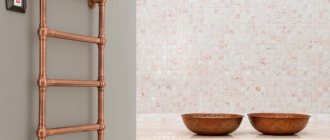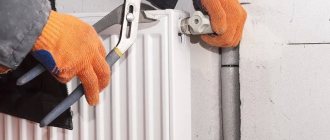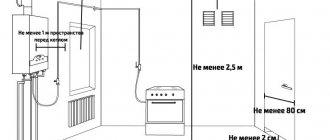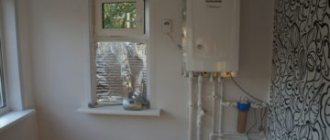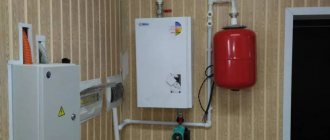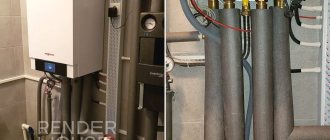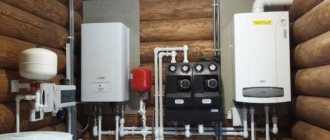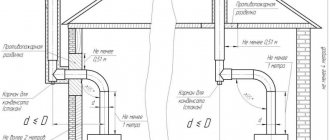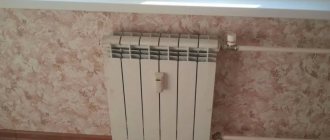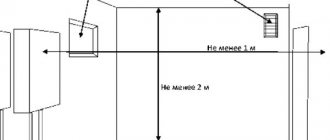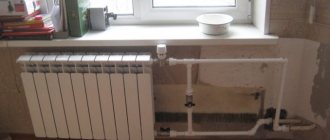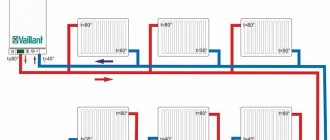What rules and regulations require installing a heated towel rail?
What are heated towel rails for? Is it really not possible to dry towels by hanging them on the loggia, in the bathroom or in the kitchen?
Everything is very simple. The heated towel rail provides additional heating of the air in the bathroom, bringing the temperature to a comfortable level. This is especially true when we get out of the bathroom wet.
The temperature that does not allow you to feel discomfort at this moment was determined experimentally and is prescribed in SanPiN 2.1.2.2645-10, paragraph 4.1. which reads as follows: “Heating and ventilation systems must ensure acceptable microclimate and indoor air conditions. The optimal and permissible microclimate parameters in the premises of residential buildings are given in Appendix 2 to these sanitary rules.”
Below is a table from the specified Appendix 2:
As you can see, the acceptable temperature in the bathroom is from 17 to 26 degrees. There is almost always 17 degrees in a living room and in this case there is no need to install a heated towel rail. But it is quite difficult to ensure an optimal temperature of 23°C without additional heating in a bathroom where there are no heating radiators.
What not to do
All the above schemes work stably. As you noticed, all bends go straight, without bends in the form of an arc or rings. This is not accidental - air accumulates in all irregularities, which interferes with, and sometimes completely blocks, circulation.
This scheme doesn't work
The installation of the heated towel rail in the photo is incorrect. At least two mistakes were made:
- the bends are made narrower than the center distance of the heated towel rail;
- They are made with a metal-plastic pipe with loops.
This connection simply cannot work. Metal-plastic pipes are an excellent material, but not for connecting heated towel rails. Their fittings have a very narrow lumen, which has a bad effect on circulation. Plus, air accumulates in the loops, and the flow along the upper loop, even when supplied from above, will not flow - too much hydraulic resistance to the water must be overcome.
Unstable circuits
The following two schemes may work, but not always. At the bottom of the heated towel rail, the water stagnates and, given any difference in height, cannot rise. No one can say specifically when it will work and when it won’t. Depends on the pressure in the riser, the diameter of the pipes and the design of the dryer itself.
Unstable connection schemes
With such a connection, even a working connection may suddenly (usually after stopping) stop working. Everything is simple: the pressure has changed, the pipes are clogged, the water from below is not “pressed”, the heated towel rail does not heat.
Another option for an unstable circuit is with a loop on top. Again, it will work under certain conditions. But sooner or later the highest point will become airy and block the circulation. The problem can be helped by installing an automatic air vent at the highest point, but if the pressure drops, it will not save you.
With loop on top
Not true at all
The photo below shows examples of what not to do. Schemes without a tap on the bypass are inoperative. What this threatens is known. In addition, after several years of use, they will stop functioning altogether. Most likely this will happen after the next shutdown - the system will become clogged with dirt. This is because the entire flow of hot water is directed through the heated towel rail. After repairs, the water carries a huge amount of dirt, which safely settles in the bends (in the lowest areas first). Within a few years everything becomes completely clogged. Fortunately, everything needs to be redone and connected correctly, but only flushing can help the fire.
Very bad idea
It is necessary to wash both the heated towel rail and the connections to it. To do this, remove the dryer and wash it in the bathroom, and wash the outlets one by one by connecting a hose to the free outlets, the other end of which is taken to the sewer. By manipulating the taps, pass a flow of hot water through one outlet, then through the other. After washing everything is put back in place. It may be possible to start the system after this.
Heated towel rail against mold and mildew
As you can see, one of the functions of a heated towel rail is to maintain a temperature that is comfortable for taking a bath or shower. But it also has one more important function, much more important, but not prescribed in SanPiNs and SNiPs. This is to ensure stable ventilation and reduce humidity in the bathroom.
The bathroom differs from all other rooms in the house by its specific microclimate. This is where we take a shower, enjoy a hot bath, perform daily hygiene procedures and wash clothes. Water vapor accumulating in the bathroom air creates high humidity, which can be fatal not only for the building materials used in finishing, but also for our health.
Under the influence of humidity in the absence of reliable ventilation in the corners, behind false ceilings, under baseboards and behind false walls made of plasterboard, mold and mildew may soon appear, which not only spoil the appearance of the room, but also destroy building materials in the process of their vital activity - the plaster cracks and crumbles, cracks appear, the air is filled with a heavy smell of mold, and fungal spores that multiply in the warm, humid air of the bathroom can become a health hazard, causing lung diseases.
It would seem - what does a heated towel rail have to do with it? And the heated towel rail is here because it allows you to quickly dry the air in the room, preventing the appearance of fungus and mold.
In addition, warmer air with a lower density rushes into the exhaust openings of the ventilation system, providing reliable draft and allowing moist air to be quickly removed from the bathroom.
Functions of a heated towel rail in the bathroom
1. Drying towels and linen
Obviously, one of the main purposes of a heated towel rail is to dry towels. This is a convenient additional detail, on which it is convenient to hang small items - underwear, towels, socks, rags, for which there is not enough space on a regular battery.
2. Bathroom heating
Even such a small device as a coil can save you in the cool season, when cold and dampness reign throughout the entire apartment, including the bathroom. A dryer adds warmth to a room and helps things dry faster.
For water heated towel rails operating from a hot water supply and heating system, there is one problem - idle time during periods of water outage. If you prefer to control the operation of the dryer yourself, purchase an electric product. Like water ones, they will do an excellent job of heating. For spacious bathrooms, it is better to choose a large heated towel rail - usually these are electric heated towel rails - ladders, which, in addition to their large size, are also distinguished by a larger number of rungs than coils.
3. Removing excess moisture
High humidity is a standard problem in the bathroom, which is difficult to cope with with ventilation alone. When humidity is high, mold and mildew appear on walls, ceilings, and in the joints between tiles. In such situations, you cannot do without a heated towel rail.
As an additional means of heating, you can also use a heated floor, which will not only heat the bathroom, but also create pleasant warmth under your feet, as well as quickly dry the surface.
Installation types
Heated towel rails can be divided into three groups according to the type of installation:
- floor-standing, most often - these are water models,
- wall-mounted, they can be electric or water,
- portable, powered by electricity, easily moved around the bathroom or transferred to other rooms.
Installation of models connected to the hot water supply of the house is carried out to the walls or floor. If the bathroom is small, then the best option would be to install a wall-mounted model; a ladder heated towel rail, for example, will not take up much more space than a towel rack. You can choose the appropriate model: electric or water type.
When choosing wall-mounted models, special attention should be paid if the wall on which you plan to install it has different levels, in particular if it is half tiled. The model should be selected with the expectation that it will be placed above or below the cladding boundary; it may be possible to find one that can be installed on a wall with a level difference.
There is nothing special to say about installing a portable device; a person who has no idea about construction or installation tools can plug it into a power outlet.
Types of heated towel rails
When choosing drying equipment, most consumers pay all attention to its shape and design. In principle, this is correct, because a heated towel rail in a bathroom immediately attracts attention, so it should look harmonious in the interior of the room.
You definitely need to pay attention to the heating method.
All heated towel rails are divided into three types, which have different characteristics. Before making a purchase, you should understand all the nuances.
Water appliances
This type of equipment is practical and affordable, which is why it is in great demand. The device starts working after connecting to the hot water supply.
Water appliances are operated continuously as long as there is hot water in the pipes.
During operation, scale will accumulate inside the pipes, problems with valves and dampers are possible, so the product must be of high quality. The average lifespan of water heated towel rails is 30 years.
Electrical devices
Externally, the electric model of the device is similar to the water model, but it produces less heat. An electric heated towel rail does not require hot water.
Its installation requires the installation of a special outlet in the room, which must be protected from moisture.
The device runs on electricity, which means that electricity consumption will increase.
The surface of the equipment heats up evenly and quickly, due to the fact that inside the pipes there is not water, but vegetable and mineral oil or other solutions with high thermal conductivity.
Some products have a water heating cable inside the pipes.
Combined options
A combined heated towel rail is essentially a water model with electric internals. The device is made from thin-walled pipes and connected to hot water supply using an intermediate heat exchanger.
Such devices are characterized by increased durability, safety and uniform heating of the room.
Typical mistakes of independent craftsmen
When, with a side or bottom connection, the lower outlet is located above the extreme point of the PS, a stagnation zone is formed between the bottom of the device and the connection point of the lower outlet.
This is a consequence of the fact that the cooled liquid, having dropped down, cannot get back into the riser due to the pressure on it from a column of hot water with a lower specific gravity. As long as the permissible height difference between the bottom outlet and the bottom of the heated towel rail is not exceeded, the device works, and after that the circulation in it stops.
Circulation will also stop if there is a bend formed by the upper pipe. The only way to make such a scheme work is by inserting a Mayevsky tap to periodically bleed off the accumulated air. Sometimes a loop is made in the upper pipe, laying it behind the ceiling trim, and the lower pipe is walled into the floor.
Air will accumulate at the top, and the cooled water in the unit will be blocked in the lower loop located in the floor. The movement of the coolant will stop completely.
Operating principles of the heating system
This connection option does not pose any technical difficulties. A heated towel rail is a heating device installed in almost every city apartment. From a constructive point of view, this is an external element of communications through which hot coolant or hot water of the DHW system circulates. Such elements are often installed as a compensating loop of the heating system, playing the role of an additional source of heat in rooms with high humidity. The name of the element speaks for itself, hence the serpentine shape, thanks to which you can effectively use the heated circuit.
For aesthetics, heated towel rails are usually made of stainless steel or plated with nickel. The design itself and the method of connecting the heated towel rail to the centralized communication make it possible to connect a water floor pipe to it without much difficulty. As a rule, small diameter pipes are used for heated floors. For a bathroom, the area of which rarely exceeds 4-5 m2 in a city apartment, only 15-20 meters of pipe will be required.
There are two types of heated towel rails:
- a coil that is connected to a centralized heating system;
- a coil that is connected to a centralized hot water supply.
In the first case, with the onset of the heating season, water fills the heated towel rail and accordingly enters the heated floor circuit, heating the floor surface.
The first option only works during the heating season. The rest of the time your heated floor will be inactive. A coil connected to the DHW system looks preferable. Such a floor in the bathroom will always work, providing a good microclimate and comfortable temperature.
Scheme No. 1: lateral and diagonal connections, non-narrowed and unbiased bypass.
The most effective connection for the vast majority of substations (exceptions will be added a little later) is with the supply of coolant to the upper part and the release of cooled coolant from the bottom. This can be achieved by using a lateral or diagonal connection with an unnarrowed and unbiased bypass.
Figure 12. Connection of a PS ladder operating on natural circulation, without narrowing and without bypass displacement. Lateral connection.
Figure 13. Connection of a PS ladder operating on natural circulation, without narrowing and without bypass displacement. Diagonal connection.
The schemes are equivalent; the diagonal version has practically no advantages over the lateral one.
This PS connection diagram is the most universal:
- Works in any direction of supply in the riser.
- It is completely independent of the circulation speed in the riser.
- There is no need to bleed air from the substation after turning off the water.
- The distance from the riser is arbitrarily large.
Conditions for the circuit to work:
- The lower outlet of the riser must be below the connection point to the substation, and the upper outlet of the riser must be above the connection point to the substation.
- It is necessary to observe the slope of the supply pipes (the direction is shown in the figure). To be certain, you can take a difference of 3...30mm per meter. More is better. At small distances from the riser (a couple of meters) and a large diameter of the supply pipes (PPR 32mm), strictly horizontal laying is permissible.
- There should be no “humps” (completely unacceptable, otherwise air will accumulate in them and circulation will stop) or dips on horizontal routes (allowed only within small limits; deep “holes” will serve as “pockets” for airing).
- With bottom feed, there should definitely be no narrowing between the bends! It will interfere with the operation of the PS until it becomes completely inoperable! With top supply, in extreme cases, it is permissible to narrow the bypass by 1 step of the riser diameter (we will consider this option in detail below), but it is not required for the operation of the substation.
- The diameter of the pipes to ensure maximum circulation is preferably at least DN20 (3/4" for steel, 25mm for good reinforced PPR), ball valves - at least 3/4". The practical maximum distance of the substation from the riser when using a plastic pipe with a diameter of 25 mm is approximately 4.5 meters.
- It is highly desirable to place the supply pipes in thermal insulation. In addition to the fact that this is mandatory when embedding any plastic pipes (provides mechanical protection and compensation for thermal expansion), such insulation can improve the performance of the substation in certain cases (sagging pipes or “holes” in them).
It is strictly prohibited to install any taps on the bypass - this is vandalism and harm to yourself and your neighbors. Overlapping or excessive narrowing of the bypass:
- a) Slows down circulation throughout the riser (the temperature of hot water drops from water collection points in apartments).
- b) Radically worsens the water pressure in all apartments located further in the direction of supply. And with a certain location of the hot water outlet - even to the vandal himself. Indeed, when the bypass is narrowed by one pipe size, its throughput becomes approximately half as large.
- c) Does not significantly improve the efficiency of the above scheme, and with a lower feed, even on the contrary, it interferes with the operation of the substation.
Heated floor design instead of a heated towel rail
High-quality work directly depends on a properly installed substrate. It consists of 5 main components:
- insulation from possible leaks;
- metal mounting mesh;
- thermal insulation;
- damper tape compensating for various expansions;
- one type of screed (dry or wet).
On average, the thickness of such a substrate is 5–15 cm.
The essence of the design is that metal-plastic pipes are fixed together into fragments, placed on a substrate and fixed to the collectors. The coolant circulates through the latter, and the return is returned. Warm floors are a low-temperature design, because their heating does not exceed 45 °C.
Reference! For improved heating of the room, it is better to use ceramic tiles or concrete screed as a floor covering.
Advantages
- No interference with finishing the room;
- preservation and saving of heat consumption. This is especially true for rooms with high ceilings;
- Absolutely environmentally friendly. This design does not have a negative impact on human health.
Flaws
- Expensive installation of heated floors;
- administrative ban on installation of this structure;
- increase in floor weight due to layering of the substrate in the bathroom.
Manufacturers of heated towel rails
There are a great many manufacturers of radiators, both foreign and domestic. English, Belgian, German and Italian radiators are considered the recognized leaders in the heated towel rail market.
Of course, these are quite high quality models, but their prices are too high. Then you should pay attention to domestic brands of heated towel rails:
- "Nika" is a St. Petersburg company that uses imported components for the production of radiators;
- "Sunerzha" is a company that produces stainless steel heated towel rails; large assortment and quite good quality;
- AquaStal produces both economy and premium models.
These are the most famous companies here in Russia. Which heated towel rail is best is up to you to decide.
Connecting a water heated towel rail to hot water supply or central heating
Heated towel rails can be connected to a hot water supply (DHW) or heating system. The first option allows you to dry bath accessories throughout the year, because... hot water is not turned off during the warm season. The dryer pipes heat up only when the coolant is consumed, so the device cools down completely overnight.
When connected to the heating network, you can use the heated towel rail only in the cold season. However, due to the forced circulation of hot water, it will remain warm around the clock.
Copper and brass heaters must be marked as galvanized and suitable for water supply risers.
Installation in a riser
The dryer is inserted in the following sequence:
- Preparation of materials and tools. To install a water heater you will need an adjustable wrench, a grinder, dies for threading, a low-speed drill, telescopic brackets, dowels and screws, American type taps, a Mayevsky tap (for air release), straight and corner fittings (depending on the type connections), sealant and sealant for joints. The system itself is assembled from a heated towel rail, a bypass jumper and several pipes, the length of which is selected depending on the layout and location of the device.
- Dismantling of old equipment. Work to remove the old device and/or install a new one will require permission from the management company (MC). Its employee closes the common hot water or heating riser for a regulated time. If there is an old dryer, it is removed from the threaded connections or cut off, and then removed from the mounts (brackets). If you are just planning to install the device, then a gap is cut out in the riser, which is slightly larger than the width of the heater.
- Preparation of bends and lintels, laying tiles. Ball valves are installed on the branches after the bypass. You can fix the system before finishing the room, but in this case the thickness of the glue and tiles is added to the distance to the wall.
- Marking for fastenings. It is carried out taking into account the slope of the branches, the horizontal position of the heater and the distance between its parts. After checking the markings, you can drill holes, screw in dowels and install brackets.
It is recommended to install a towel dryer during a major renovation of an apartment or when replacing a water riser. This will allow you to choose more reliable material options and a convenient connection diagram.
Self-installation of a simple configuration
Installation of the coil is carried out after completion of the preparatory work. Branch pipes, angles and fittings are connected to the finished bends. Each connection is sealed with fum tape or silicone gasket.
Installation of the heated towel rail is carried out simultaneously on the bends and installed brackets. The device is secured with screws.
Upon completion of work, the system is tested for functionality and tightness. The DHW or heating riser is temporarily opened, filling the heater with water. If the connection is made correctly, it circulates freely in the system, the joints do not get wet, and the metal surface remains hot.
Before installing the system yourself, you should watch training videos with instructions for installing the dryer (step by step and with all fittings).
Technology for working with the “Ladder” model
For heated towel rails of the “ladder” type, predominantly lateral and diagonal installation schemes are used. For bottom connections, you can install rotating angles and additional pipes on the bends, which will allow pipes to be brought in from the side.
The installation sequence of the device is the same as for the coil. The shape of the heater is taken into account only when choosing the layout and marking of the mounting. The brackets are installed at 2 points at the level of the middle of the “ladder”.
Connection to a centralized heating system
Tapping into the heating system can only be done outside the cold season. To do this, you will have to obtain permission from the management company, shut off the riser and drain the cold water.
To prepare the bends, it is better to invite a specialist from the management company. Having a document with a list of work performed will allow you to relieve yourself of responsibility in the event of an accident. The risk of leaks on the heated towel rail itself is minimized by shut-off taps after the bypass.
A significant disadvantage of tapping into the heating system is a delayed leak test.
General principle
Connecting a water heated towel rail to a hot water or heating riser is no different. All schemes are identical. The only difference is seasonality. There is almost always hot water supply (if there is one at all), heating is only available in the cold season.
The water heated towel rail is connected by separate pipes: the connection diagram for the heated towel rail in general, without considering particulars
In any case, the heated towel rail is connected through special and separate connections. It does not consume water/coolant, it only takes away some of the heat. Therefore, DHW consumption may not be counted. Heating is an issue. This is essentially a heating device. So it can be considered as a radiator.
Connecting a heated towel rail in a country house
Installing a heater in a private home has a number of advantages:
- permission from the Criminal Code and notification of neighbors are not required;
- the dimensions of the device are not limited to standard bathroom sizes in apartment buildings;
- if you have your own clean well, the pipes are not clogged with sediment and dirt, you can purchase an imported system that is demanding on the quality of the coolant;
- the owner can install shut-off valves at any point, because stopping water circulation does not affect its availability and temperature for other DHW users.
In country houses, the device is installed according to the same algorithm as in an apartment.
Briefly about the main thing
All the nuances of installing and sealing a gas meter in an apartment or private house
Bathroom heated towel rails are made from various metals. This determines the permissible pressure that can be created inside the product.
The heat source can be electricity, hot water supply or a heating system. Depending on this, it is necessary to pull a cable with a terminal socket or install connecting circuits between the riser and the equipment.
The choice of dryer is based on material, coolant and size. The latter is justified by building codes, according to which it is necessary to maintain specific distances to plumbing fixtures, floors, and furniture.
There are several schemes for connecting units: lateral, diagonal, horizontal (top or bottom)
In the case of liquid coolant, it is important to monitor the location of the outlets on the riser in relation to the pipes on the heated towel rail. They must be straight or with vertical inserts, but without loops
Then the independent circulation of water will not be disrupted and air will not form in the system.
When replacing a water heated towel rail, you must contact utility services to turn off the riser and obtain permission to install the selected model. Not always, but in some cases, drafting and approval of project documentation is required.
Energy efficient heated towel rails
A rational approach to the selection of home appliances and electric heating devices used in the house implies the use of energy-efficient ones. Taking this point into account, new models are equipped with operating mode switches and timers.
However, it is most beneficial to keep the heated towel rail on all the time - maintaining the set temperature will require less energy than periodically heating a completely cooled device.
As for timers, their presence allows for more comfortable operation of the device - you can set the turn-on time in advance, calculating how much time it will take to heat the towels and the room itself.
No less convenient are models equipped with a thermostat - users are given the opportunity to program the device to obtain a certain, comfortable temperature.
Materials for work
In private homes, water heated towel rails are mainly installed, which are connected directly to the heating system.
When connecting the device, you must use the following materials:
- shut-off valves;
- fittings – couplings, bends, bends;
- air vent valve;
- mounting tow or tape;
- fastening elements - dowels, brackets, bolts, screws.
To connect a heated towel rail in a private home, you will need installation tow.
Experts recommend installing a bypass on the heated towel rail, which is a piece of pipe with tees at the edges. In this case, ball valves are mounted at the ends of the dryer.
